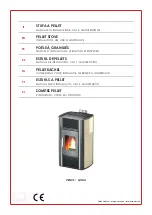
ACTUAL
20
03.27660.200
Add extra fuel when necessary. Never add too much fuel. It is best to fill the stove
for one third and to top it up on a regular basis.
Always open the filling door slowly and for a short space at a time. Before filling up,
the charcoal bed should be carefully spread open. Check whether the coals are glow-
ing enough just behind the log retainer, so that the added fuel will immediately
catch fire. If necessary you can open the primary air slide for a while.
Open stacking will make the logs burn very intensely, as the oxygen can easily reach
every part of the fire. This method of stacking is applied when burning wood for a
short while. Compact stacking will make the fire burn slower, as the air can only
reach the outer parts of the fire. This stacking method is best used when burning for
a longer while.
Low intensity fires cause tar and creosote to deposit in the chimney after a long
period of time. Tar and creosote are highly combustible substances. Thicker layers
of these substances might catch fire when the temperature in the chimney increases
suddenly and steeply. Therefore it is necessary for the fire to regularly burn very
intensely, so that thin layers of tar and creosote immediately disappear.
Low intensity fires also cause tar to deposit on the stove panes and doors.
When it is not too cold outside it is better to let the stove burn intensely for just a
few hours a day.
4.5.
Low heating (for devices suitable for continuous use)
To use the device as a ‘continuous fire’, you can select the primary and secundaire
air scoops in such a way you get the right burning speed. Always make sure ther’s
enough glow on the heating bottom.
4.6. Ash removal
The bottom of the fire compartment is equipped with a port to eliminate the ashes.
Open the port (see picture) and sweep the redun-
dant ashes into the ashtray by means of the scrap-
er. With the "cold hand", you can pull the ashtray
from the stove (see picture).
Relatively speaking, burning wood produces little
ash and it will not be necessary to remove it each
time daily. The ash in the cavities between the ribs
of the fire plate does not need to be removed,
since wood burns better on a bed of ash.
4.7.
Extinguishing the fire
Stop fuelling the fire and let it burn out.
Damping a fire by closing the air slides involves the release of noxious gases. You
should let the fire burn out and keep an eye on it as long as it is still glowing.
ACTUAL
25
03.27660.200
3.2.
Vorbereitenden Arbeiten
Kontrollieren Sie das Gerät unmittelbar nach dem Erhalt auf Transportschaden und/
oder sichtbaren Schaden, und informieren Sie nötigenfalls den Lieferanten. Nehmen
Sie das Gerät in der Zwischenzeit nicht in Betrieb.
Um Beschädigung des Gerätes während der Installation zu vermeiden und um das
Gerät leichter manipulieren zu können, wird Ihnen empfohlen zuerst alle losen Teile
(feuerfeste Steine, Aschenlade, ...) aus dem Gerät zu entfernen. Merken Sie sich die
Stelle dieser Teile, damit Sie sie nachher wieder ordentlich einbauen können.
Das Gerät wird mit den nachstehenden Hilfsmitteln geliefert:
A: Rohr Ø150 (1x)
B: Fuß (4x)
C: Handgriff (1x)
D: Entaschungsklappe (1x)
E: Holzgriffhalterung (1x)
F: Schlüssel für Verriegelung Rohrverschlussklappe
(1x)
G: Feuerfeste Ofen Kitt (1x)
H: Schrauben Holzgriff (1x)
1: Unterlegscheibe M8 (4x)
2: Schraubenmutter M8 (4x)
3: Linsenschraube M8 (1x)
4: Senkschraube M8 (2x)
5: Winkel (1x)
6: Abstandsbolzen (1x)
7: Bolzen (1x)
8: Schraubenmutter M6 (1x)
9: Senkschraube M8 (1x)
10: Unterlegscheibe M6 (1x)
3.2.1. Rauchgasentsorgung
Ihr Gerät ermöglicht einen Ober- bzw. Hinteranschluss.
Montage des Abgasstutze Ø150 Nr. A:
Befestigen Sie der Abgasstutze Nr. A mit Hilfe der
Schrauben Nr.4, der Unterlegscheiben Nr.1 und der
Schraubenmuttern Nr.2.
Verwenden Sie zum Abdichten die feuerfeste Ofen Kitt.



































